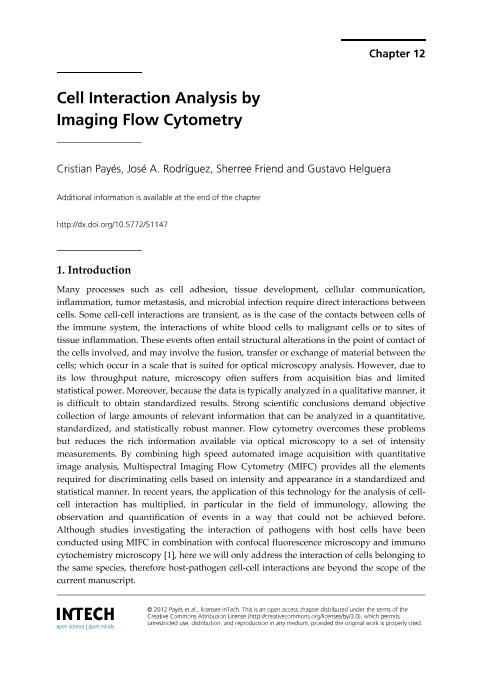Mostrar el registro sencillo del ítem
dc.contributor.author
Payés, Cristian

dc.contributor.author
Rodríguez, José A.

dc.contributor.author
Friend, Sherree
dc.contributor.author
Helguera, Gustavo Fernando

dc.contributor.other
Gowder, S.
dc.date.available
2021-04-05T12:52:05Z
dc.date.issued
2012
dc.identifier.citation
Payés, Cristian; Rodríguez, José A.; Friend, Sherree; Helguera, Gustavo Fernando; Cell Interaction Analysis by Imaging Flow Cytometry; IntechOpen; 2012; 303-322
dc.identifier.isbn
978-953-51-0792-7
dc.identifier.uri
http://hdl.handle.net/11336/129346
dc.description.abstract
Many processes such as cell adhesion, tissue development, cellular communication, inflammation, tumor metastasis, and microbial infection require direct interactions between cells. Some cell-cell interactions are transient, as is the case of the contacts between cells ofthe immune system, the interactions of white blood cells to malignant cells or to sites oftissue inflammation. These events often entail structural alterations in the point of contact ofthe cells involved, and may involve the fusion, transfer or exchange of material between thecells; which occur in a scale that is suited for optical microscopy analysis. However, due toits low throughput nature, microscopy often suffers from acquisition bias and limitedstatistical power. Moreover, because the data is typically analyzed in a qualitative manner, itis difficult to obtain standardized results. Strong scientific conclusions demand objectivecollection of large amounts of relevant information that can be analyzed in a quantitative,standardized, and statistically robust manner. Flow cytometry overcomes these problemsbut reduces the rich information available via optical microscopy to a set of intensitymeasurements. By combining high speed automated image acquisition with quantitativeimage analysis, Multispectral Imaging Flow Cytometry (MIFC) provides all the elementsrequired for discriminating cells based on intensity and appearance in a standardized andstatistical manner. In recent years, the application of this technology for the analysis of cell-cell interaction has multiplied, in particular in the field of immunology, allowing theobservation and quantification of events in a way that could not be achieved before.
dc.format
application/pdf
dc.language.iso
eng
dc.publisher
IntechOpen

dc.rights
info:eu-repo/semantics/openAccess
dc.rights.uri
https://creativecommons.org/licenses/by-nc-sa/2.5/ar/
dc.subject
Antibody
dc.subject
Cytotoxicity
dc.subject
ADCC
dc.subject
Cell Interaction
dc.subject.classification
Otras Ciencias de la Salud

dc.subject.classification
Ciencias de la Salud

dc.subject.classification
CIENCIAS MÉDICAS Y DE LA SALUD

dc.title
Cell Interaction Analysis by Imaging Flow Cytometry
dc.type
info:eu-repo/semantics/publishedVersion
dc.type
info:eu-repo/semantics/bookPart
dc.type
info:ar-repo/semantics/parte de libro
dc.date.updated
2020-08-19T19:34:35Z
dc.journal.pagination
303-322
dc.journal.pais
Estados Unidos

dc.journal.ciudad
New York
dc.description.fil
Fil: Payés, Cristian. Consejo Nacional de Investigaciones Científicas y Técnicas. Oficina de Coordinación Administrativa Houssay; Argentina
dc.description.fil
Fil: Rodríguez, José A.. No especifíca;
dc.description.fil
Fil: Friend, Sherree. No especifíca;
dc.description.fil
Fil: Helguera, Gustavo Fernando. Consejo Nacional de Investigaciones Científicas y Técnicas. Oficina de Coordinación Administrativa Houssay; Argentina
dc.relation.alternativeid
info:eu-repo/semantics/altIdentifier/url/https://www.intechopen.com/chapters/39831
dc.relation.alternativeid
info:eu-repo/semantics/altIdentifier/doi/http://dx.doi.org/10.5772/51147
dc.conicet.paginas
322
dc.source.titulo
Cell Interaction
Archivos asociados
